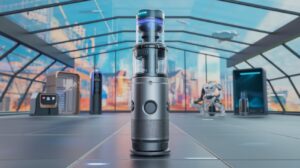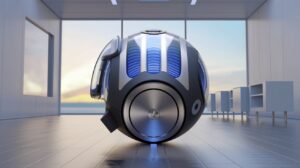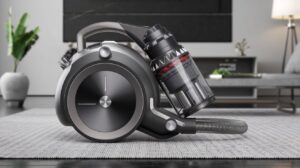Vacuum Cleaner Trends to Watch in 2025
The world of vacuum cleaners is evolving rapidly, with 2025 shaping up to be a game-changing year for innovation, sustainability, and convenience. Homeowners are increasingly seeking appliances that not only perform exceptionally well but also integrate seamlessly into their modern lifestyles.
This article dives into the top vacuum cleaner trends to watch in 2025, highlighting advancements in technology, eco-conscious designs, and user-centric features.

1. Introduction
In 2025, vacuum cleaner technology is set to redefine household cleaning with cutting-edge innovations and smarter designs. Modern homeowners demand appliances that blend performance with convenience, and the market is responding with advanced features like AI-powered vacuums, energy-efficient models, and quieter motors.
The rise of smart home ecosystems has also paved the way for highly connected devices, making cleaning easier and more efficient. Additionally, sustainability is taking center stage, with eco-friendly materials and energy-saving modes becoming standard.
This year promises a shift towards quieter, more versatile, and compact designs, tailored to meet diverse consumer needs. Whether it’s tackling pet hair, improving air quality, or streamlining cleaning routines, vacuum cleaners in 2025 are built to transform the way we maintain our homes. Read on to explore the trends shaping the future of household cleaning.
2. Smart Technology and Connectivity
Integration with Smart Homes
Smart vacuum cleaners are revolutionizing household cleaning by seamlessly integrating with smart home ecosystems. In 2025, these devices will work effortlessly with platforms such as Amazon Alexa, Google Home, and Apple HomeKit, enabling homeowners to control their vacuums through voice commands or mobile apps. Imagine saying, “Hey Google, start vacuuming the living room,” and watching your device spring into action. These integrations ensure that cleaning fits smoothly into the rhythms of modern life, offering unmatched convenience.
AI and Machine Learning in Cleaning
Artificial intelligence (AI) is taking smart vacuum cleaners to the next level. These advanced machines leverage AI and machine learning to map homes, understand cleaning preferences, and adapt to varying surfaces. By learning the layout of your home, they can identify high-traffic areas and optimize their cleaning paths. Some models even differentiate between delicate rugs and hardwood floors, adjusting suction levels automatically to avoid damage.
Automation Enhancements
The automation capabilities of vacuums in 2025 are nothing short of remarkable. Features like multi-room navigation, LiDAR-powered mapping, and real-time obstacle detection make cleaning more efficient. Modern robot vacuums can now clean entire homes on a single schedule, skipping over restricted areas while focusing on zones that need more attention. Customizable cleaning schedules add further flexibility, allowing users to dictate when and how their homes are cleaned—even when they’re not there.
User-Friendly App Interfaces
The rise of smart vacuum cleaners has also brought about significant improvements in app interfaces. These apps provide real-time updates, including cleaning progress, battery life, and maintenance alerts. Advanced models allow users to create virtual maps of their homes, designating specific cleaning zones and no-go areas with just a few taps. Some apps even provide cleaning analytics, helping users monitor the effectiveness of their vacuum over time.
Voice Control and Smart Alerts
Voice control functionality continues to evolve, offering homeowners an effortless way to manage their cleaning devices. Additionally, smart alerts notify users of issues like clogged filters, low battery levels, or full dustbins, ensuring optimal performance. These features combine to make smart vacuums indispensable tools for busy households.
Future Possibilities
Looking ahead, the integration of advanced AI could enable vacuums to predict cleaning needs based on household activity patterns. For example, a vacuum might suggest an additional cleaning session after a party or during shedding season for pet owners. These predictive capabilities are set to transform cleaning into a more proactive and intelligent process.
Benefits of Smart Connectivity
The benefits of smart technology and connectivity extend beyond convenience. By automating tedious tasks, these vacuums free up time for more meaningful activities. Additionally, their precision and efficiency reduce energy consumption, making them eco-friendly choices for sustainability-conscious consumers.
Challenges to Consider
While the advancements are exciting, smart vacuums aren’t without challenges. Connectivity issues, data privacy concerns, and high initial costs can deter some buyers. However, manufacturers are working to address these barriers by improving security measures, expanding compatibility, and offering budget-friendly options without compromising quality.
3. Sustainability and Eco-Friendly Designs
Demand for Green Appliances
As environmental awareness grows, consumers are prioritizing eco-friendly appliances, and vacuum cleaners are no exception. In 2025, the trend toward sustainability is evident in the materials, energy consumption, and manufacturing processes used in vacuum production. Buyers increasingly look for models made from recycled or biodegradable materials, aligning with their values to reduce environmental impact.
Energy Efficiency Innovations
Energy efficiency is another key focus in 2025. Modern vacuum cleaners now feature energy-saving modes and power optimization technologies that deliver excellent performance while consuming less electricity. These advancements are particularly beneficial for reducing carbon footprints and lowering energy bills. Some models are even designed to meet or exceed international energy efficiency standards, offering homeowners peace of mind.
Reusable and Washable Components
To reduce waste, manufacturers are creating vacuums with reusable and washable components. HEPA filters, for instance, are now designed to last longer and can be washed instead of replaced. Dustbins in many models are easy to empty and clean, minimizing the need for disposable vacuum bags. These features appeal to environmentally conscious consumers looking to make more sustainable choices.
Compact and Modular Designs
Compact, modular vacuum cleaners are gaining traction in 2025. These designs reduce material usage and are easier to repair, extending the lifespan of the appliance. Modular vacuums allow users to replace individual components rather than discarding the entire machine, further promoting sustainability. Additionally, their smaller size makes them ideal for urban living spaces where storage is limited.
Focus on Durability
Durability is another crucial aspect of eco-friendly design. Long-lasting vacuums not only reduce waste but also save money for consumers. Leading manufacturers now offer extended warranties and repair services to ensure their products stand the test of time. By emphasizing durability, companies are addressing the growing demand for appliances that combine quality with sustainability.
Renewable Energy in Manufacturing
Many vacuum cleaner brands are adopting renewable energy sources for their manufacturing processes. Solar and wind-powered facilities are becoming more common, reducing the overall carbon footprint of production. These efforts reflect a commitment to sustainability that resonates with environmentally conscious consumers.
Eco-Certifications and Labels
Certifications like Energy Star and eco-labels play an important role in guiding consumers toward greener choices. These labels indicate that a vacuum meets specific environmental standards, making it easier for buyers to identify sustainable options. In 2025, more manufacturers are seeking these certifications to highlight their commitment to eco-conscious practices.
Benefits of Eco-Friendly Vacuums
Eco-friendly vacuums offer numerous benefits beyond environmental impact. They often feature quieter motors, improved air filtration, and longer lifespans, enhancing overall usability. These models are also designed with minimalistic aesthetics, appealing to modern homeowners who value style and functionality.
Challenges in Going Green
Despite the progress, there are challenges to adopting sustainability in vacuum cleaner design. Eco-friendly materials can increase production costs, leading to higher retail prices. Additionally, not all consumers are aware of the benefits of green appliances, requiring manufacturers to invest in education and marketing efforts. However, as awareness grows, the demand for sustainable vacuums is expected to rise.
Future Outlook
The future of sustainable vacuum cleaners looks promising, with ongoing advancements in materials, energy efficiency, and manufacturing techniques. As technology evolves, we can expect even more innovative solutions that align with the global push toward sustainability. These developments not only benefit the environment but also cater to the needs of conscious consumers seeking smarter, greener appliances.

4. Advanced Filtration Systems
HEPA Filters and Beyond
HEPA filters have long been the gold standard for air purification, but 2025 brings innovations like ultra-fine particle filters that trap even smaller allergens. These advancements ensure cleaner indoor air for households, particularly those with allergy sufferers.
Air Quality Monitoring
Some high-end vacuum cleaners now include air quality sensors, providing real-time feedback. This feature is invaluable for users seeking to maintain a healthy home environment.
Anti-Allergen Features
Anti-allergen vacuums are designed to tackle pet hair, dust mites, and other irritants effectively. Look for models with sealed systems that prevent particles from escaping back into the air.
5. Noise Reduction Innovations
Quieter Motors
Vacuum cleaners are becoming noticeably quieter, thanks to advancements in motor technology. Noise levels are being reduced without compromising suction power, making them ideal for households with babies, pets, or noise-sensitive members.
Insulation Techniques
Enhanced insulation materials are being used to muffle operational noise. This improvement ensures that vacuuming can be done anytime, even during early mornings or late evenings.
Why Noise Matters
Noise pollution can be stressful. Quieter vacuums improve the overall user experience, allowing homeowners to clean without disturbing their household’s peace.
6. Multi-Surface and Specialized Cleaning
Versatility for Different Floor Types
Vacuum cleaners in 2025 are more adaptable than ever, transitioning seamlessly between hardwood, carpet, tile, and rugs. Multi-surface cleaning modes ensure optimal performance on any surface.
Pet-Friendly Features
Pet owners will appreciate vacuums equipped with specialized brushes and enhanced suction systems for removing pet hair and dander. Anti-tangle technology further prevents hair from clogging the machine.
Specialized Attachments
Attachments for corners, stairs, upholstery, and other hard-to-reach areas are now more innovative. Expect ergonomic designs and tools that make deep cleaning easier and more effective.
7. Compact and Space-Saving Designs
Cordless Models Dominating the Market
Cordless vacuums are leading the way in portability and convenience. Improved battery life ensures extended cleaning sessions without interruptions, making cords a thing of the past.
Foldable and Stowable Designs
Space-saving designs cater to urban dwellers and those with limited storage. Foldable handles and compact units make vacuums easier to store in tight spaces.
All-in-One Devices
The trend toward multi-functionality continues, with vacuums that combine sweeping, mopping, and even air purification. These all-in-one devices streamline cleaning tasks and save space.
8. Subscription and Service Models
Consumable Delivery Services
Many brands now offer subscription services for consumables like filters and cleaning solutions. Automatic delivery ensures users always have what they need without manual reordering.
Repair and Maintenance Plans
Extended warranties and on-demand repair services are gaining popularity. These plans give consumers peace of mind and extend the lifespan of their devices.
Software Subscriptions for AI Models
AI-enabled vacuums may come with premium features unlocked through software subscriptions. These include advanced cleaning modes, data insights, and firmware updates.
9. Innovations in Power and Battery Life
Longer Runtime Cordless Vacuums
Breakthroughs in battery technology are enabling cordless vacuums to run longer on a single charge. Some models now boast runtimes of up to two hours, ideal for larger homes.
Faster Charging
Quick-charge technology is becoming a standard feature, reducing downtime and allowing vacuums to be ready for use in under an hour.
Eco-Power Modes
Eco-power modes optimize energy usage, providing just the right amount of suction for lighter cleaning tasks. This feature conserves battery life while maintaining performance.
10. Price Trends and Accessibility
Premium vs. Affordable Options
The market is balancing high-end, feature-rich models with affordable options that still deliver quality performance. This ensures that innovations reach a broader audience.
Emergence of Mid-Tier Products
Mid-tier vacuums are becoming increasingly popular, bridging the gap between budget and premium models. These products offer solid performance without the hefty price tag.
Impact of Technology on Pricing
As technology advances, many features that were once exclusive to high-end models are becoming standard in lower-priced options, making cutting-edge vacuums more accessible.
11. Consumer Preferences in 2025
Health and Wellness Focus
Consumers are prioritizing vacuums that contribute to a cleaner, healthier home environment. Features like allergen control and air purification are highly sought after.
Aesthetic Appeal
Modern vacuums are designed with aesthetics in mind, featuring sleek finishes and colors that complement home interiors.
Ease of Use
Intuitive controls, lightweight designs, and ergonomic handles are becoming essential features, making vacuums more user-friendly.
12. Challenges and Opportunities in the Market
Challenges
- High competition among brands.
- Balancing sustainability with affordability.
- Meeting diverse consumer demands.
Opportunities
- Expanding into emerging markets.
- Partnering with smart home ecosystems.
- Developing personalized cleaning solutions.
13. Conclusion
The vacuum cleaner industry in 2025 is at the forefront of innovation, blending smart technology, sustainability, and convenience. Whether it’s through AI-powered features, eco-friendly designs, or noise reduction innovations, the trends outlined here showcase how vacuums are evolving to meet the needs of modern households. By embracing these advancements, consumers can enjoy cleaner, healthier, and more efficient homes while staying ahead of the curve.
